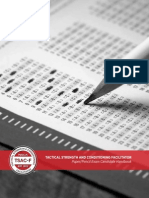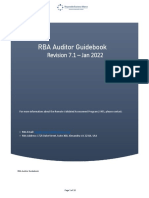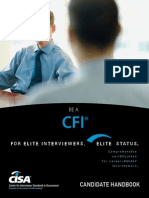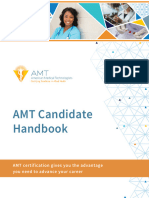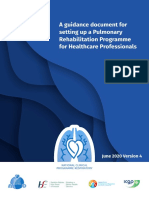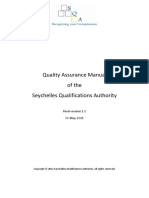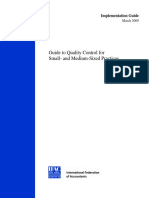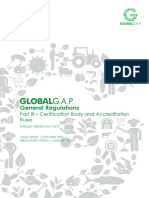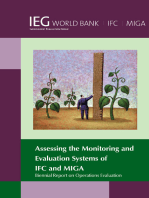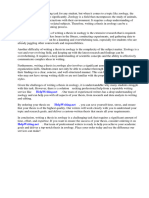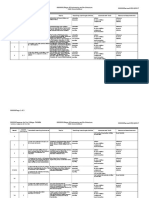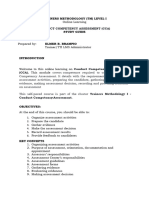2024 04 23 Clinical Exam Spec.V0.6 for Website Update
Uploaded by
vinit mann2024 04 23 Clinical Exam Spec.V0.6 for Website Update
Uploaded by
vinit mannClinical Examination Specifications
Australian Medical Council Limited | April 2024
“The purpose of the Australian Medical Council is
to ensure that standards of education, training and
assessment of the medical profession promote and
protect the health of the Australian Community.”
Australian Medical Council | Clinical Examination Specifications | V0.6| Page 1 of 29
Table of Contents
1. General introduction .................................................................................................. 4
1.1. Purpose of the document ....................................................................................................... 4
1.2. Privacy ................................................................................................................................... 4
1.3. Aims and objectives of the AMC examination process ......................................................... 4
1.4. Standard of the AMC examination ......................................................................................... 4
2. The Clinical Examination ........................................................................................... 5
2.1. General objective of the clinical examination ........................................................................ 5
2.2. Pre-requisites for the clinical examination ............................................................................. 5
2.3. Standard of performance required ......................................................................................... 5
2.4. Applying for the clinical examination ..................................................................................... 6
2.5. Workplace based assessment ............................................................................................... 6
2.6. Scheduling process for the clinical examination .................................................................... 6
2.7. Venue and scheduling ........................................................................................................... 6
2.8. Examination fees ................................................................................................................... 7
2.9. Structure of the clinical examination ...................................................................................... 7
2.9.1. Examination online ........................................................................................................ 7
2.10. Assessment criteria ............................................................................................................... 7
2.10.1. Online examination ....................................................................................................... 8
2.11. Standard of the clinical examination ...................................................................................... 8
2.12. Content of the clinical examination ........................................................................................ 8
2.13. Formal notification of clinical examination results ................................................................. 9
3. Marking in the structured clinical assessment examination ................................ 10
3.1. Key steps ............................................................................................................................. 10
3.2. Domains ............................................................................................................................... 10
3.3. The global rating .................................................................................................................. 10
3.4. Use of recordings for marking.............................................................................................. 10
3.5. Pass requirements ............................................................................................................... 10
4. Feedback .................................................................................................................. 11
5. Process of the online clinical examination ............................................................ 12
5.1. Before the examination ........................................................................................................ 12
Australian Medical Council | Clinical Examination Specifications | V0.6| Page 2 of 29
5.2. Starting the examination ...................................................................................................... 12
5.3. During the reading time ....................................................................................................... 12
5.4. During the station ................................................................................................................. 12
5.5. Finishing early ...................................................................................................................... 13
5.6. Station content and equipment ............................................................................................ 13
5.7. Physical examination stations.............................................................................................. 13
5.8. Rest stations ........................................................................................................................ 13
5.9. The final notification ............................................................................................................. 13
5.10. Prohibited materials ............................................................................................................. 13
6. Candidate Conduct .................................................................................................. 14
6.1. General conduct of candidates ............................................................................................ 14
6.2. Unsatisfactory Results ......................................................................................................... 14
6.3. Irregular Behaviour .............................................................................................................. 15
7. Preparation for the clinical examination ................................................................ 16
7.1. Review of clinical skills ........................................................................................................ 16
7.2. General preparation for the clinical examination ................................................................. 16
7.2.1. Planning for the examination ...................................................................................... 17
7.2.2. During and after the examination ................................................................................ 17
7.3. AMC Certificate .................................................................................................................... 17
7.4. Appeals procedure ............................................................................................................... 17
8. General information ................................................................................................. 18
8.1. Change of address .............................................................................................................. 18
8.2. Further information .............................................................................................................. 18
Appendix A: The AMC graduate outcome statements ................................................... 19
Appendix B: A clinical assessment station sample ....................................................... 25
Australian Medical Council | Clinical Examination Specifications | V0.6| Page 3 of 29
1. General introduction
1.1. Purpose of the document
These specifications have been prepared to assist candidates for the Australian Medical
Council (AMC) clinical examination. Candidates should make themselves fully aware of the
information provided.
1.2. Privacy
The AMC observes the provisions of the Privacy Act which sets out the requirements for the
collection and use of personal information collected.
Each of the Application Forms required by the AMC includes a statement relating to the AMC’s
privacy procedures. Each must be signed by the applicant to give formal consent for the AMC
to collect and hold personal information.
Please note: if this consent is not provided, the AMC will not be able to process the
application.
The AMC’s full Privacy Policy may be found on the AMC web site at
http://www.amc.org.au/about/privacy-policy.
1.3. Aims and objectives of the AMC examination process
The AMC examination process assesses, for registration purposes, the medical knowledge
and clinical skills of international medical graduates whose basic medical qualifications are not
recognised by the Medical Board of Australia.
The process is designed as a comprehensive test of medical knowledge and clinical
competence. There are two stages, the computer adaptive testing (CAT) multiple-choice
question (MCQ) examination and the clinical examination. Both the MCQ and clinical
examination are multidisciplinary and integrated.
The MCQ examination focuses on basic and applied medical knowledge across a wide range
of topics and disciplines, involving understanding of disease process, clinical examination,
diagnosis, investigation, therapy and management, as well as on the candidate’s ability to
exercise discrimination, judgment and reasoning in distinguishing between the correct answer
and plausible alternatives. The MCQ is a computer-administered examination of three hours
and thirty minutes duration and consists of 150 questions. For more information on the MCQ
examination, please click here for access.
The clinical examination assesses the candidate’s capacity in such areas as history taking,
physical examination, diagnosis, ordering and interpreting investigations, clinical
management, prescribing and communication with patients, their families and other healthcare
workers.
1.4. Standard of the AMC examination
The standard of the AMC examination is formally defined as the level of attainment of medical
knowledge, clinical skills and professional behaviours that is required of newly qualified
graduates of Australian medical schools who are about to commence intern training. These
are described in the AMC graduate outcome statements listed in Appendix A.
Australian Medical Council | Clinical Examination Specifications | V0.6| Page 4 of 29
The graduate outcomes form the basis of medical education in Australia and are used to
accredit medical schools. They are expressed in terms of four overarching domains:
1) Clinical Practice: the medical graduate as practitioner
2) Science and Scholarship: the medical graduate as scientist and scholar
3) Health and Society: the medical graduate as a health advocate
4) Professionalism and Leadership: the medical graduate as a professional and leader
2. The Clinical Examination
2.1. General objective of the clinical examination
The general objective of the AMC clinical examination is to assess the clinical competence of
the candidate for the safe and effective clinical practice of medicine in the Australian health
care system.
The clinical examination will be offered in the online format in 2024, as described below or on
the AMC website.
2.2. Pre-requisites for the clinical examination
Candidates must have passed the MCQ examination before being eligible to proceed to the
clinical examination.
2.3. Standard of performance required
The clinical examination requires the candidate to demonstrate, to the satisfaction of the
examiners, clinical ability at the level of a graduating final year medical student about to
commence the (pre-registration) intern year, across a broad range of required clinical
disciplines.
The candidate is required to:
• be familiar with the common and important health promotion strategies, health disorders,
prevention strategies and related issues in the Australian community and have some
awareness of other less common health issues in the Australian community
• take a competent history, perform a competent physical examination, arrive at relevant
diagnoses and differentials, order or interpret relevant investigations, describe/explain
management plans and prescribe common medications safely
• be familiar with the indications for, the mechanisms and actions of, and the adverse effects
of, the major therapeutic agents
• explain and justify an approach to a patient's problem(s)
.
Australian Medical Council | Clinical Examination Specifications | V0.6| Page 5 of 29
2.4. Applying for the clinical examination
Candidates may only apply for one examination at a time. Therefore, candidates who have
been scheduled for a clinical examination may not lodge an application for another
examination before they have received the results of the scheduled examination.
Candidates who have lodged a Clinical examination appeal may not lodge an application for
another examination until the results of that appeal have been received.
2.5. Workplace based assessment
Candidates who have been accepted into a position in an AMC accredited workplace based
assessment (WBA) program and who have not commenced, who are in the process of
completing the WBA program, or are awaiting their WBA results, may not apply for a position
in a clinical examination.
For further information regarding WBA, please see:
http://www.amc.org.au/assessment/pathways/standard/wba
2.6. Scheduling process for the clinical examination
The Clinical examination scheduling process includes –
• Once an examination is open for scheduling, candidates will be able to log into their
candidate portal and directly apply for their preferred examination date.
• Payment of the examination fee is ONLY accepted by credit card. There will be a 15-
minute period to complete payment for the examination, once this has lapsed, the
placement will be released to the next candidate. Please note that Cheque payment is not
accepted for scheduling of Clinical examinations
• Once payment has been successfully processed, a placement letter and receipt
confirming candidate examination details will be available immediately to download from
the candidate portal
• Once the examination placements have been filled, the AMC will compile a cancellation
list. To be put on this list, candidates must email [email protected] (please note
telephone requests will not be accepted). In the event that a candidate is unable to proceed
with their examination, candidates on the cancellation list will be contacted to fill the
available position. Please note the cancellation list does not guarantee an examination
placement and is only valid for the month that is open for scheduling
For further information regarding examination closing dates, please see:
http://www.amc.org.au/assessment/clinical-exam/clinical-events
2.7. Venue and scheduling
All Clinical Examination in 2024 will be delivered online.
Candidates must log on and report to the tAMC team in attendance no later than the time
advised in the examination schedule. Once candidates have reported, they will be required to
remain, under the direction of the administrative staff, until the examination session concludes.
Due to the multi-station structure of the examination, candidates logging in late will not be
permitted to commence the examination.
Australian Medical Council | Clinical Examination Specifications | V0.6| Page 6 of 29
2.8. Examination and Withdrawal fees
Payment of the examination fee will confirm the placement in the relevant clinical examination
session.
If a candidate has been scheduled in the clinical examination and then subsequently
withdraws, there will be no refund - except in an exceptional circumstance as determined by
the AMC Chief Executive Officer or nominee. To withdraw, a candidate must submit a
Withdrawal Form, which can be found here.
The fees for the AMC examination are reviewed from time to time and are subject to variation.
The examination fees for the clinical examination are shown on the AMC website
(http://www.amc.org.au/).
2.9. Structure of the clinical examination
The AMC clinical examination is an integrated multidisciplinary structured clinical assessment.
2.9.1. Examination online
This is a 16-station examination administered on line via a video conferencing format at a
___location organised by the candidate and approved by the AMC.
Candidates will rotate through a series of stations and will undertake a variety of clinical tasks.
All candidates in a clinical examination session will be assessed against the same stations.
Most stations are of 10 minutes duration (comprising two minutes reading time, and eight
minutes assessment time.
Stations may use actual patients, simulated patients, or videotaped patient presentations.
Other relevant materials, such as charts, digital images and photographs may also be used in
the examination.
There are four rest stations in addition to the 16 stations. Rest stations will not be scored, but
will provide candidates with an opportunity to have a supervised break between the assessed
stations.
2.10. Assessment criteria
Stations will assess clinical skills relating to presentations of medical, surgical, women’s
health, paediatrics and mental health problems. These will be in a variety of settings including
community and hospital.
Each station has a single broad “predominant assessment area”. These are:
• history taking
• examination
• diagnostic formulation
• management/counselling/education.
Examples of material that could be included in the stations are:
• taking the history of a patient with symptoms of shortness of breath [history taking station]
• taking a history from a third party such as the parent or carer of a patient (history taking
station)
• physical examination of a patient with symptoms of suspected vascular disease
[examination station]
Australian Medical Council | Clinical Examination Specifications | V0.6| Page 7 of 29
• interpretation of a laboratory report result [diagnostic formulation station]
• diagnosis of a common skin lesion [diagnostic formulation station]
• educating an asthmatic patient on the use of an inhaler
[management/counselling/education station]
• counselling a patient with obesity [management/counselling/education station]
• presenting a management plan for a patient presentation
(management/counselling/education station).
Examiners from all disciplines contribute to the assessment process.
2.10.1. Online examination
• The format of examination stations has been developed for online delivery. The
assessment blueprint and criteria remain the same as the in-person NTC examination with
the exception of hands-on components of physical examination.
• Physical examination skills will be tested at as high a level as possible in the online
environment.
• The candidate will be required to exhibit clinical reasoning, interpretation and detailed
description of physical examination techniques and process.
• The candidate may be delivering this information to either the examiner, medical student,
patient, family member, carer or health professional.
Examiners from all disciplines contribute to the assessment process.
2.11. Standard of the clinical examination
The clinical examination requires the candidate to demonstrate their ability in a range of clinical
tasks in a series of clinical scenarios. The competence of the candidate is measured against
the standard expected of the graduating medical student at an Australian university.
2.12. Content of the clinical examination
The scenarios used in the assessed stations comprise:
• a clinical stem of essential information to the candidate about the scenario, which may
include investigations, imaging or charts
• a series of tasks, commonly three to four
• a suggested timing for the main task(s)
Each scenario has a single “predominant assessment area” (namely history, physical
examination, diagnostic formulation, or management/counselling/education). Assessment
tasks will be focussed on this area, but may include other areas.
During the reading time the candidate evaluates the given information and plans their
approach to the assessment phase. They should plan their time, taking into account the
number and type of tasks, and take careful note of any given time guidelines.
During the assessment time the candidate conducts the interaction as required and performs
the designated clinical tasks.
The clinical tasks include but are not limited to; history taking, physical and mental state
examination, investigation planning and interpretation, diagnostic formulation, management
planning, prescribing, counselling and performance of procedures.
A clinical scenario may test a candidate's ability in responding to these tasks in various health
care settings, including:
Australian Medical Council | Clinical Examination Specifications | V0.6| Page 8 of 29
• community or general hospital services
• metropolitan, regional or remote locations
• any phase of health care: preventative, acute/critical care and continuing care
• any patient age group: newborn to aged
• direct patient care, carer and family interactions or multidisciplinary team interactions.
A clinical scenario may be based on normal development, health promotion /prevention or on
any common and/or important diseases or syndromes, from any clinical system.
Any time guidelines are also indicated to candidates during the station by a time prompt.
2.13. Formal notification of clinical examination results
Candidate results will be available from the AMC in accordance with the process notified on
the AMC website - http://www.amc.org.au/assessment/clinical-examination/clinical-results
Please note: Under no circumstances will results be given over the telephone.
Australian Medical Council | Clinical Examination Specifications | V0.6| Page 9 of 29
3. Marking in the structured clinical
assessment examination
Each station has a predominant assessment area that defines the main aim of the station.
The marking system for the examination contains three components, (i) key steps, (ii) domains
and (iii) the global score. Each station will have several key steps and domains that are
relevant to that station.
A sample of a structured clinical assessment station is at Appendix B.
3.1. Key steps
Typically in each station, there will be between two and five key steps that a candidate is
expected to demonstrate. These are marked as ‘observed’ or ‘not observed’.
3.2. Domains
Typically, there will be between three and five assessed domains in each station. The
candidate performance on each separate ___domain is rated on a seven-point scale. There is no
pass/fail point for these ratings.
Domains may include (but are not limited to) such items as approach to the patient, history
taking, choice and technique of physical examination, accuracy of physical examination,
differential diagnosis, choice or interpretation of investigations, management, and patient
education/counselling.
The expectations of the candidate are described specifically for each ___domain as relevant to
the individual station.
3.3. The global rating
Finally the examiner makes a global rating of the candidate’s overall ability on the station,
again on a seven-point scale. The global rating takes into account the predominant
assessment area of the station as well as all aspects of the candidates’ performance as
demonstrated in the station.
The global rating alone determines the pass/fail performance on the station. A score of three
or below constitutes a fail score, and four or above constitutes a pass score (in the global
rating only)
3.4. Use of recordings for marking
The examiner will generally mark the candidate’s performance based on observation during
the course of the station. However if there is some technological problem that prevents the
examiner from properly observing the candidate during the station, then the examiner may
use a recording of the station to mark the candidate’s performance.
3.5. Pass requirements
The 16 assessed stations will include two pilot stations. A pilot station is a station that is being
used in a clinical examination for the first time. Pilot stations:
Australian Medical Council | Clinical Examination Specifications | V0.6| Page 10 of 29
• Have been developed by a discipline writing group and approved by the Clinical
Assessment Panel for pilot status
• Have no statistics from previous examinations.
Pilot stations may also be stations requiring trialling for administrative purposes including
stations with special operational and technology requirements.
A candidate’s overall examination result (pass or fail) will be determined by 14 scored stations.
Usually the scored stations will not include either of the two pilot stations, but if there is an
issue with one or two of the non-pilot stations the Clinical Results Panel may determine that
one or both of the pilot stations will be substituted. If this occurs the candidate’s result will still
be determined on the basis of 14 stations. Over the 14 stations candidates will be graded as
pass or fail, as follows:
• A pass will be awarded where a candidate obtains a pass score in 9 or more of the 14
assessed stations.
• A fail will be awarded where a candidate obtains a pass score in 8 or less of the 14
assessed stations. There is no limit on the number of attempts a candidate may have
at the clinical exam.
4. Feedback
A number of aspects of a candidate’s performance can be used to provide feedback to the
candidate.
It is important to note however, that the scores for the aspects of the marking that are reported
as part of the feedback provided to candidates do not directly or numerically determine an
overall result of a pass or a fail for the station. The pass/fail result is determined by the
examiner making a separate global rating about a candidate’s performance across all aspects
of the station, not just those for which feedback has been provided.
Although the aspects of a station that are reported as part of the feedback provided to
candidates may contribute to an examiner's global rating, it is not possible to determine
whether a global rating that would result in a station being passed or failed was obtained for a
station simply by looking at the scores associated with the aspects of the station provided in
the candidate feedback.
Each candidate will receive a computer-generated breakdown of their performance against
selected aspects of the station marks to assist with revision for future attempts.
Australian Medical Council | Clinical Examination Specifications | V0.6| Page 11 of 29
5. Process of the online clinical
examination
5.1. Before the examination
Ensure your email and contact number (mobile) is up to date.
Candidates must arrive by the time specified for the examination. Candidates who are not
present as required by the time indicated will not be permitted to commence the examination.
The required dress standard for candidates is professional attire.
Candidates who may require special assistance during the examination should inform the
AMC as early as possible prior to their examination. This may include medication requirements
or food intake due to a medical condition.
5.2. Starting the examination
On logging into the examination link provided by the AMC, candidates will be welcomed by
the Examination Coordinator. The Coordinator will perform an ID, security and environment
check and provide the exam conditions and a candidate briefing video about the examination
process.
Candidates will be moved to their starting station where an invigilator will inform the candidate
when the examination will commence. A notification will indicate the start of the two-minute
reading time of the candidate’s first station.
A second notification will indicate the start of the examination and candidates will then
commence the station. In most stations there are eight minutes to complete the tasks.
A Final notification will conclude the first station.
Candidates will be moved to a rest/breakout station until the next station starts. The candidate
will be rotated in and out of stations by the Examination Coordinator.
Some candidates will start at a rest station and will be required to stay in the rest station for
the first 10 minutes. The invigilator will advise if this is the case.
5.3. During the reading time
During the reading time candidates evaluate the given information and plan their approach to
the assessment phase. They should plan their time, taking into account the number and type
of tasks, including any given time guidelines.
Candidates should pay close attention to the time guidelines provided.
5.4. During the station
During the assessment time the candidates conduct the interaction as required and perform
the designated clinical tasks.
The examination will proceed through all stations in this manner.
Australian Medical Council | Clinical Examination Specifications | V0.6| Page 12 of 29
5.5. Finishing early
If candidates finishes a station early, this does not mean that they have done well or failed. It
merely means the task has been completed ahead of the allotted time.
Candidates who complete a station before the allocated time are required to wait in the station
until the conclusion of the 8 minutes. They may return to the tasks at any time before the
assessment time is completed.
5.6. Station content and equipment
Stations may use actual patients, simulated patients, or video patient presentations. Other
relevant materials, such as charts, digital images and photographs may also be used in the
examination.
5.7. Physical examination stations
Physical examination stations online will be of 5 or 10 minutes total duration. The time will be
clearly stated. There will be two minutes reading time for an eight minute station, and one
minute reading time for a four minute station. Candidates should follow the station tasks
exactly as they are described.
5.8. Rest stations
All rest stations are supervised by the invigilator. Candidates are permitted to leave the rest
station to attend the bathroom. Candidates must advise the invigilator should they wish to
attend the bathroom. If candidates do not require use of the bathroom, they are required to
remain in the room, in front of the camera and will continue to be supervised by the
invigilator.
Candidates may finish their examination at a rest station and will be required to wait until the
final notification sounds before being allowed to conclude their examination.
5.9. The final notification
When the examination has finished, a notification will advise candidates that the examination
has concluded and they can log out of the examination.
5.10. Prohibited materials
No books, textbooks, notes, items of jewellery, tie pins or other materials are allowed into the
examination room, including recording devices, watches (smart, digital and analogue) or
handbags. Candidates are not permitted to write any prompting material on their skin before
or during the examination.
In order for candidates and the AMC to communicate with each other in the event of a technical
issue, candidates will be permitted to have their mobile phone switched to silent in the same
room. Candidates will be required to show the invigilator that their phone is switched to silent.
Only one phone is to be in the examination room.
The invigilator or coordinator may request to view any items or the examination room itself
prior to, during, or after the examination if necessary.
If candidates may require any medications during the examination, they should bring this to
the attention of the AMC prior to the examination day and the invigilator before the examination
starts.
Australian Medical Council | Clinical Examination Specifications | V0.6| Page 13 of 29
6. Candidate Conduct
6.1. General conduct of candidates
Candidates are expected to conduct themselves courteously in examinations,
correspondence and in personal contact with examiners, patients (actual or simulated),
employees or agents of the AMC and other candidates. Candidates whose conduct is
disruptive, or is considered by the AMC to have been outside the bounds of reasonable and
decent behaviour, may be excluded from the examination and/or refused the opportunity to sit
future AMC examinations.
All candidates must comply with the instructions of all clinical examination staff during
examinations. Failure to do so will constitute a breach of examination procedures and may
result in the candidate being excluded from the examination or refused the opportunity to sit
future examinations.
For exams at the NTC, family and friends accompanying candidates to an examination are
NOT permitted to enter the examination venue.
For exams online – Candidates must advise people in the household or other venue that they
are sitting an examination and cannot be interrupted.
Professional boundaries are crossed when any interaction of an unwanted or sexual nature
occurs between a doctor and the patient or an immediate family member of the patient. The
Medical Board of Australia has codes of practice on this matter.
A doctor who crosses professional boundaries while undertaking the AMC clinical examination
may be guilty of professional misconduct and may be investigated and subjected to
disciplinary action by regulatory authorities.
Candidates in clinical examinations are expected to observe fully the confidentiality of patients
and simulated patients who participate in the examination and should not discuss the personal
details of the consultations outside the examination at any time, with any person.
6.2. Unsatisfactory Results
A feature of the Clinical examination is that because it enables analysis of a candidate’s
performance, the AMC can form a reliable opinion as to whether the candidate’s performance
in the examination can be confidently accepted as a fair reflection of the candidate’s ability.
Under the Health Practitioner Regulation National Law, which regulates registration of doctors
in Australia, a fundamental principle is to provide for the protection of the public.
Accordingly, if on analysis the AMC becomes concerned that the candidate’s performance
may not be confidently accepted as a fair reflection of the candidate’s ability, the AMC may
identify this concern to the candidate and seek an explanation. The CEO of the AMC will
consider the issue, including any explanation from the candidate, and determine whether to
withhold a result from the candidate because the CEO decides that the candidate’s result
cannot be confidently accepted as a fair reflection of the candidate’s ability. (This may come
about because, for example, analysis indicates that a candidate’s results have been materially
affected by pre-knowledge of questions or rote learning or regurgitation of pre-learned
answers.)
Australian Medical Council | Clinical Examination Specifications | V0.6| Page 14 of 29
In this circumstance the candidate will be invited to attempt the Clinical examination
again.
6.3. Irregular Behaviour
Any attempt to circumvent the objectives or processes of the examination (as described in
these Specifications or in other material made available to candidates), the reliability of
candidate assessment, or the security of the examination or examination content, may:
a) produce exam results which cannot be confidently accepted as reflecting a candidate’s
true ability,
b) compromise the integrity and security of the Clinical examination and Clinical
examination content, and/or
c) detract from or impede the AMC purpose of protecting the health of Australian patients
and communities.
Accordingly, any candidate:
• found with recording equipment, or recording any aspect of the examination during the
examination; or
• who discloses or attempts to disclose or compromise the examination content or
procedures (including but not limited to, supplying, offering to supply, selling, or offering
for sale materials or details purporting to be AMC examination content); or
• who acts in any way that is in breach of the AMC’s intellectual property rights in the
examination content or procedures, or inconsistent with those rights; or
• who cheats, or receives or seeks inappropriate outside assistance in their performance
in any examination; or
• who otherwise behaves in any inappropriate manner such that the AMC cannot have
confidence that the assessment of the candidate is an accurate reflection of the
candidate’s ability; or
• who provides inappropriate assistance to another candidate, such that the AMC cannot
have confidence that the assessment is an accurate reflection of that other candidate’s
ability; or
• who participates in an examination for a purpose other than a genuine desire to pass
that examination, or whose performance in the examination is particularly poor such that
it appears that the candidate’s purpose in attempting the examination is other than a
genuine desire to pass that examination;
may be subject to the following disciplinary processes:
• Any concern identified by the Clinical Results Panel will be reported by the Clinical
Results Panel to the AMC CEO for review. The Clinical Results Panel may withhold
awarding a result for the examination.
• The candidate will be informed of the concern in writing and provided with an
opportunity to respond.
• The AMC CEO will consider all the material, including any response from the candidate,
and will determine a final decision regarding the candidate examination result.
• The AMC CEO may also decide that the candidate may not be permitted to continue
with any AMC assessment, may be refused the opportunity to sit future examinations,
Australian Medical Council | Clinical Examination Specifications | V0.6| Page 15 of 29
may have their results in the examination withdrawn, may be refused a result for the
examination, may be refused the award of the AMC certificate, may have their AMC
certificate withdrawn, and/or be reported to the appropriate authorities including the
Medical Board of Australia/Australian Health Practitioner Regulation Agency
(MBA/AHPRA) or law enforcement authorities.
• Where a concern is identified during the course of a Clinical examination and reported
to the authorised authority conducting the examination, the same person may direct that
the candidate be immediately excluded from the examination, and the matter be referred
to the Clinical Results Panel for further investigation in accordance with these
specifications.
All AMC candidates should be aware that, under Australian law, copyright of all examination
materials rests with the Australian Medical Council. No part of any examination may be
reproduced, stored or transmitted by any means.
7. Preparation for the clinical
examination
7.1. Review of clinical skills
AMC clinical examiners recommend that candidates undertake a comprehensive review of
their clinical skills in the four main predominant assessment areas. Particular attention in
preparing for the clinical examination needs to be paid to reviewing foundation clinical skills,
clinical competence and patient safety to the required standard, and to practising all aspects
of consultation skills and doctor-patient communication in clear, non-technical English.
Experience suggests that a review of journals that contain articles dealing with common
clinical conditions in the Australian community will be more effective in preparing for the clinical
examination than spending too much time with reference books. Books concerning physical
examination skills are essential as are online materials from reputable sources. Candidates
are encouraged to obtain as much practice as possible to assist in preparing for demonstrating
their clinical skills in the examination.
The AMC examiners also consider that candidates who are able to maintain continuing contact
with the practice of clinical medicine in a teaching hospital or other relevant clinical service
can significantly improve their chances of success in the AMC examination. It is in each
candidate's best interest to identify their clinical strengths and weaknesses and to focus their
efforts on overcoming any basic clinical deficiencies before sitting the examination.
The MCQ examination feedback may provide a useful guide to areas of strength and
weakness in clinical knowledge.
7.2. General preparation for the clinical examination
The following points are suggested to assist candidates in planning for and sitting the clinical
examination..
Australian Medical Council | Clinical Examination Specifications | V0.6| Page 16 of 29
7.2.1. Planning for the examination
The clinical examination is not designed to retest knowledge. Candidates should therefore
focus on comprehensively reviewing and practising their clinical skills.
Candidates should:
• Get a good night’s rest before presenting for the examination
• Avoid the use of stimulants or other drugs that may impair their performance
• Read their placement letter carefully and note the times and for NTC examinations the
exact ___location of their examination
• Ensure they arrive/attend on time for their clinical examination session and give
themselves time to settle down before the examination commences
• If travelling from interstate, ensure that they check any interstate time differences and allow
extra time in case of delayed flights or travel time between the airport and the city.
7.2.2. During and after the examination
Candidates should:
• carefully read any preliminary data supplied, and take especial note of tasks given
• not overlook the fact that there may be simulated or real patients in the clinical
examination. Examiners will take note of the manner in which a candidate addresses and
deals with the patient. Medical practitioners have a duty of care to patients, and patients
in the examination have a right to receive the same care.
• avoid discussing patients with other candidates who may attend the clinical examination
in the future, because patients are rotated and, in some cases, alternative conditions are
examined in patients with multiple clinical signs. Any candidate who attempts to formulate
a diagnosis or management on the basis of information provided by other candidates,
without having seen the patient themselves, is likely to compromise their assessment.
7.3. AMC Certificate
Candidates who pass either the MCQ and clinical, or MCQ and WBA assessment processes
and whose medical degree (final medical diploma/primary qualification) was accepted
(outsourced and/or verified) by Educational Commission for Foreign Medical Graduates
(ECFMG) a member of Intealth will be issued with an AMC Certificate. A candidate’s
certificate will be available to view/print from their AMC account after completion or passing
thereof. Please allow up to 3-5 business days from when the results are released for the
certificate to be generated.
It should be noted that the AMC certificate is available to the Medical Board of Australia,
AHPRA to view for registration purposes and to a nominated specialist medical college for
their assessment purposes.
7.4. Appeals procedure
The AMC has established procedures for candidates to lodge an appeal regarding the clinical
examination. This process is outlined in the Appeals rules which are found on the AMC website
at - www.amc.org.au. An appeal application form is also found on the website.
Important Note: Candidates who lodge an appeal for a clinical examination may not apply for
another clinical examination until the outcome of the appeal has been received by the
candidate.
Australian Medical Council | Clinical Examination Specifications | V0.6| Page 17 of 29
8. General information
8.1. Change of address
It is important that candidates advise the AMC secretariat promptly of each change of address,
email address and/or telephone number. This will ensure that contact can be made as quickly
as possible with candidates to notify them of examination venue changes, rule or eligibility
changes, or to confirm information provided by the candidate on his or her application forms.
Change of address can be made via the telephone or by using the Change of address form
which can be obtained by contacting the AMC Secretariat. The change of address form is also
available on the AMC website (https://www.amc.org.au/).
When advising of a change of address in writing, candidates should include the following
details:
• candidate number
• full name
• previous address
• new address
• candidate signature
• date of birth.
Under the provisions of the Commonwealth Privacy Act the AMC is unable to accept changes
of address or other candidate details submitted by email, unless provided on the Change of
address form.
8.2. Further information
If a candidate is in doubt about any aspect of the AMC examination, he/she should contact
the AMC Clinical team at [email protected]. or view further information on the AMC
website at www.amc.org.au.
Australian Medical Council | Clinical Examination Specifications | V0.6| Page 18 of 29
Appendix A: The AMC graduate
outcome statements
The goal of medical education is to develop junior doctors who possess attributes that will
ensure they are initially competent to practice safely and effectively as interns in Australia or
New Zealand, and that they have an appropriate foundation for further training in any branch
of medicine and for lifelong learning. Attributes should be developed to an appropriate level
for the graduates’ stage of training.
Included below is the list of graduate outcome statements. These statements, divided into four
domains, reflect the skills, knowledge and attitudes that Australian medical students are
required to demonstrate upon graduation. Graduate outcome statements can also be found in
the AMC’s Standards for assessment and accreditation of primary medical programs.
Domain 1
Clinical Practice: the medical graduate as practitioner
Domain 1 describes the graduate as a practitioner who provides person-centred care for
patients, across the stages of their patients’ life, with supervision appropriate for internship.
The graduate applies their knowledge and skills in diverse healthcare settings and with
patients with diverse needs. The graduates also place first their patients’ physical, emotional,
social, economic, cultural and spiritual needs and their patients’ geographic ___location,
recognising that these can influence a patient’s description of symptoms, presentation of
illness, healthcare behaviours and access to health services or resources.
On entry to professional practice, Australian and Aotearoa New Zealand graduates are able
to:
1.1 Place the needs and safety of patients at the centre of the care process and apply safety
skills including effective clinical handover, graded assertiveness, delegation and escalation,
infection control and adverse event reporting.
1.2 Apply whole-person care principles in clinical practice, including considering a patient’s
physical, mental, developmental, emotional, social, economic, environmental, cultural and
spiritual needs and their geographic ___location.
1.3 Practise sensitive and effective communication with patients and their families and
carers that promotes rapport and elicits needs, concerns and preferences.
1.4 Demonstrate flexible, adaptive and effective communication that supports health literacy
and the needs of patients and their families and carers.
1.5 Demonstrate culturally safe practice with ongoing critical reflection on their own
knowledge, skills, attitudes, bias, practice behaviours and power differentials to deliver safe,
accessible and responsive healthcare free of racism and discrimination.
1.6 Demonstrate empathic communication with patients and their families and carers
through respect for Aboriginal and/or Torres Strait Islander and Māori knowledges of
wellbeing, Aboriginal and/or Torres Strait Islander and Māori healthcare models, and
obligations to Aboriginal and/or Torres Strait Islander and Māori people when providing
Australian Medical Council | Clinical Examination Specifications | V0.6| Page 19 of 29
culturally safe care. In Aotearoa New Zealand, the obligations to Māori people include those
under Te Tiriti o Waitangi.
1.7 Integrate knowledge of the health issues and diseases that affect Aboriginal and/or
Torres Strait Islander and Māori patients across medical disciplines when providing culturally
safe care.
1.8 Elicit an accurate, structured medical history from the patient and, when relevant, from
families and carers or other sources, including family, social, occupational, lifestyle and
environmental features.
1.9 Demonstrate competence in relevant and accurate physical and mental state
examinations.
1.10 Integrate and interpret findings from the history and examination to make an initial
assessment, including a relevant differential diagnosis and a summary of the patient’s mental
and physical health.
1.11 Provide accessible information on options, rationales, costs, risks, harms and benefits
of health interventions to enable patients and their families and carers to make fully informed
choices about the management of their health.
1.12 Demonstrate the ability to adapt management proposals to the needs and
communication requirements of patients and their families and carers.
1.13 Apply scientific knowledge and clinical skills to care for patients across their lifespan,
including as children, adolescents and ageing people, and patients in pregnancy and
childbirth.
1.14 Demonstrate competence in the procedural skills required for internship.
1.15 Select, justify, request and interpret common investigations, with due regard to the
pathological basis of disease and the efficacy, safety and sustainability of these investigations.
1.16 Work within the interprofessional team to identify and justify management options, based
on evidence, access to resources and services, and on the patient’s needs and preferences.
1.17 Prescribe and, when relevant, administer medications safely, appropriately, effectively,
sustainably and in line with quality and safety frameworks and clinical guidelines.
1.18 Prescribe and, when relevant, administer other therapeutic agents including fluid,
electrolytes, blood products and inhalational agents safely and in line with quality and safety
frameworks and clinical guidelines.
1.19 Record, transmit and manage patient data accurately and confidentially.
1.20 Recognise, assess and respond to deteriorating and critically unwell patients who need
immediate care, including those with physical, mental or cognitive condition deterioration,
communicating critical information and escalating care as required.
1.21 Demonstrate competence in emergency and life support procedures.
1.22 Apply preventive health approaches, such as screening and lifestyle advice, including to
support the ongoing management of chronic conditions.
1.23 Apply the principles of quality care for patients at the end of their lives, avoiding
unnecessary investigations or treatment, aligning care with patient values and preferences,
Australian Medical Council | Clinical Examination Specifications | V0.6| Page 20 of 29
and ensuring physical comfort including pain relief, psychosocial support and other
components of palliative care.
1.24 Demonstrate digital health literacy and capability in supporting patients and their families
and carers to use technology for promoting wellbeing and managing health concerns.
Domain 2
Professionalism and Leadership: the medical graduate as a professional and leader
Domain 2 describes the graduate as a practitioner who provides care to all patients according
to Good medical practice: a code of conduct for doctors in Australia and standards of clinical
and cultural competence and ethical conduct for doctors, as relevant to the ___location of their
medical education and practice. The graduate also demonstrates understanding of the ethical
and legal frameworks relevant to their workplace, and has both knowledge of professional
standards, and the ability and aptitude to always practise within them. This includes reflecting
on their practice, recognising their own limits and committing to life-long learning. The
graduate applies the principles of leadership and effective teamwork in interprofessional teams
and contributes to supportive working and learning environments for all healthcare
professionals.
On entry to professional practice, Australian and Aotearoa New Zealand graduates are able
to:
2.1 Display ethical and professional behaviours including integrity, compassion, self-
awareness, empathy, discretion and respect for all.
2.2 Apply the principles of professional leadership, followership and teamwork in healthcare
by providing care within interprofessional healthcare teams.
2.3 Demonstrate an understanding of the ethical dimensions of medical practice, and
explain the main ethical frameworks used in clinical decision-making.
2.4 Communicate effectively with patients, their families and carers and other healthcare
professionals regarding the options and implications of ethical issues related to patient care.
2.5 Recognise the complexity and uncertainty inherent in the healthcare of diverse patients
and be aware of the limits of their own expertise.
2.6 Engage with the interprofessional team to optimise patient outcomes, particularly to
manage complexity and uncertainty.
2.7 Demonstrate awareness of professional limitations and actively monitor and address
personal wellbeing, fatigue, health and safety to support self-care and patient care. This
includes seeking support when needed and following the relevant advice of a trusted health
professional.
2.8 Manage their time, education and training demands and show ability to prioritise
workload to manage patient outcomes and health service functions.
2.9 Respect the boundaries that define professional and therapeutic relationships in clinical
practice.
2.10 Explain the options available when personal values or beliefs may influence patient care,
including the obligation to effectively refer patients to another practitioner.
Australian Medical Council | Clinical Examination Specifications | V0.6| Page 21 of 29
2.11 Describe and show respect for the roles and expertise of healthcare and other
professionals.
2.12 Demonstrate the ability to learn and work collaboratively as a member of an
interprofessional team.
2.13 Demonstrate lifelong learning behaviours, including seeking feedback on, reflecting on
and evaluating their own professional practice.
2.14 Seek, reflect on and use feedback in critically evaluating their own professional practice
to improve the cultural and clinical safety of their practice for colleagues, patients and their
families and carers.
2.15 Describe and apply the legal responsibilities of health professionals, including but not
limited to:
• implementing a human rights based approach to health
• accepting a duty of care to patients and colleagues
• maintaining privacy and confidentiality
• completing records, certificates and other documents
• using digital health technology
• undertaking informed consent processes
• managing financial and other conflicts of interest
• applying mandatory reporting mechanisms.
2.16 Apply the principles of effective near-peer teaching, appraising and assessing.
2.17 Contribute to psychosocially safe and supportive working and learning environments,
including adhering to and enacting their responsibilities under bullying, harassment, racism
and discrimination policies and processes.
2.18 Critically evaluate their own professional practice in the context of health system
structures and processes to contribute to culturally safe health environments, with particular
awareness of Aboriginal and/or Torres Strait Islander and Māori communities.
Domain 3
Health and Society: the medical graduate as a health advocate
Domain 3 describes the graduate as a practitioner who recognises the diverse needs of
patients in communities across Australia and Aotearoa New Zealand, understands the
underlying social and environmental determinants of health, and can apply strategies that
address health inequities for individual patients, communities and populations. The graduate
is committed to health advocacy to improve access and outcomes for individual patients, and
to influence system-level change in a socially accountable and environmentally sustainable
manner.
On entry to professional practice, Australian and Aotearoa New Zealand graduates are able
to:
Australian Medical Council | Clinical Examination Specifications | V0.6| Page 22 of 29
3.1 Describe differences in healthcare access, healthcare delivery and patient experiences
across diverse hospitals and community health settings in metropolitan, rural and remote
areas.
3.2 Identify the social, cultural, personal, physical and environmental determinants of health
for individuals and communities, including factors related to the ongoing impacts of climate
change.
3.3 Describe the ongoing impact of colonisation, intergenerational trauma and racism on the
health and wellbeing of Aboriginal and/or Torres Strait Islander and Māori people.
3.4 Describe the systemic and clinician implicit and explicit biases in the health system that
impact on healthcare access, experience, quality and safety for Aboriginal and/or Torres Strait
Islander and Māori people. This includes understanding current evidence around all forms of
racism as a determinant of health and how racism establishes and sustains inequities in
health.
3.5 Describe the structural barriers to accessing healthcare services and apply strategies to
increase the inclusivity of these services for community groups who experience health
inequities and Aboriginal and/or Torres Strait Islander and Māori communities by partnering
with those groups.
3.6 Apply health advocacy skills by partnering with patients and their families and carers,
and/or communities to define and highlight healthcare issues, particularly health inequities and
sustainability.
3.7 Explain, select and apply common population health screening, disease prevention and
health promotion approaches in public health.
3.8 Describe how incorporating health technologies in clinical practice can both improve
patient experiences and outcomes and present risks, particularly for community groups who
experience health inequities and Aboriginal and/or Torres Strait Islander and Māori
communities.
3.9 Describe a systems approach to improving the quality, safety, sustainability and
inclusivity of healthcare.
3.10 Describe the principles of sustainable and equitable allocation of finite resources to meet
the needs of individuals and communities now and in the future, and the roles and relationships
between health agencies, disability agencies and services in resource allocation.
3.11 Describe Aboriginal and/or Torres Strait Islander and Māori holistic concepts of
wellbeing and Aboriginal and/or Torres Strait Islander and Māori health models, including
programs and Aboriginal and/or Torres Strait Islander and Māori specific interprofessional
healthcare teams that can enhance patient health outcomes.
3.12 Describe global health issues and determinants of health and disease, including their
relevance to healthcare delivery in Australia and Aotearoa New Zealand, the broader Western
Pacific region and in a globalised world.
Domain 4
Science and Scholarship: the medical graduate as scientist and scholar
Domain 4 describes the graduate as a practitioner who is committed to expanding their
scientific knowledge and who evaluates and applies evidence to their clinical practice. The
Australian Medical Council | Clinical Examination Specifications | V0.6| Page 23 of 29
graduate recognises that research, along with quality improvement and assurance
approaches, underpins continuous improvement of clinical practice and the broader
healthcare system, and conscientiously supports these activities.
On entry to professional practice, Australian and Aotearoa New Zealand graduates are able
to:
4.1 Apply biological, clinical, social, behavioural and planetary health sciences and
informatics in health care.
4.2 Apply core medical and scientific knowledge to populations and health systems,
including understanding how clinical decisions for individuals influence health equity and
system sustainability.
4.3 Describe Aboriginal and/or Torres Strait Islander and Māori knowledges of wellbeing
and models of healthcare, including community and sociocultural strengths. Describe best
practice approaches that lead to improved and sustained positive Aboriginal and/or Torres
Strait Islander and Māori health and wellbeing outcomes.
4.4 Describe the aetiology, pathology, clinical features, natural history and prognosis of
common and important conditions at all stages of life.
4.5 Access, critically appraise and apply evidence from medical and scientific literature.
4.6 Apply scientific methods to formulate relevant research questions and identify applicable
study designs.
4.7 Comply with relevant quality and safety frameworks, legislation and clinical guidelines,
including health professionals’ responsibilities for quality assurance and quality improvement.
Australian Medical Council | Clinical Examination Specifications | V0.6| Page 24 of 29
Appendix B: A clinical assessment
station sample
Information for candidates
You are working in a general practice. Your next patient is a 37-year-old woman who suddenly
became short of breath at work yesterday.
YOUR TASKS ARE TO:
• take a relevant focused history to enable you to further evaluate this problem; you should
take no more than five minutes for this task
• obtain the relevant examination findings from the examiner; the examiner will only give
you the results of the examination findings you specifically request
• explain to the patient the probable diagnosis and the possible differential diagnoses giving
your reasons.
Information for simulated patient
You are a 37-year-old woman who has come to see your GP because of shortness of breath.
The candidate has been asked to perform the following tasks:
• take a relevant focused history from you to further evaluate this problem
• obtain the relevant examination findings from the examiner
• explain to you the probable diagnosis and the possible differential diagnoses
How to play the role:
If at any stage the candidate provides you with information which you do not understand, for
example, because of technical language or because of ambiguities, ask for clarification until
you are provided with a clear, consistent explanation in plain language. Say: 'I don't
understand what you mean, would you explain?' or 'I'm not clear about what you just said.'
Other than clarification questions, do not ask further questions; it is up to the candidate to
provide fluent advice.
Towards the conclusion of the station, if the candidate says to you: 'Do you have any
questions?' say: 'What else should I know, Doctor?'
Opening statement:
'I'm worried about my breathing. Yesterday at work I suddenly became short
of breath and I was not doing anything energetic.'
In response to further open questions such as ‘When did it all start?’ say:
'At the time, I was sitting in a meeting, and noticed quite suddenly that I was short of breath
even though I was just sitting down. At the same time I noticed I was coughing up phlegm.'
In response to further open questions such as 'Have you noticed anything else?', say:
'I don't think I've noticed anything more, although I'm still a little breathless.'
Australian Medical Council | Clinical Examination Specifications | V0.6| Page 25 of 29
In response to direct or specific questions from the candidate, provide the following information
(do not provide this in response to broad/open-ended questions):
• I couldn't sleep last night because of breathlessness and had to sleep sitting up.
• I'm not as short of breath today as I was yesterday.
• I've never had shortness of breath like this before.
• I've been able to walk on the flat easily, but have had trouble walking up stairs in the last
24 hours.
• I haven't noticed any chest pain.
• There have been no palpitations.
• I've been coughing up phlegm since developing the shortness of breath.
• It was white and clear but it had a few spots of blood in it today (only provide this detail if
the candidate asks about the phlegm colour).
• I have not fainted or lost consciousness.
• I don't have any wheezing.
• I've never had asthma.
• I have not had any fever.
• I have not had any recent colds or the flu.
• I haven't had any leg or ankle swelling.
• There's been no calf pain or tenderness.
• Three weeks ago I was on holidays in the States and arrived home six days ago (Do not
give any of this information unless travel has been specifically asked about).
• I took sleeping tablets to help me sleep during the flight. I managed to sleep most of the
way home.
• I'm not on the oral contraceptive pill or any other medications. I get my sexual partner to
use a condom.
• I have never had DVT or blood clots.
• No one in my family had DVTs or blood clots.
• I smoked about ten cigarettes a day from my late teens until about two years ago.
• I'm only a social drinker and have an occasional glass of white wine at weekends.
To other questions, respond with either 'no', 'I don’t know' or 'I'm not sure'.
Responses after candidate starts to explain the likely diagnosis
• If a diagnosis that the average patient would not know much about (i.e. pulmonary
embolism), say: 'What is that?' and 'Is it serious?'
• If only one diagnosis is mentioned, ask: 'Could it be anything else?'
• If told that you will have to go to hospital, say: 'Is that really necessary?' and: 'What will
they do?'
Australian Medical Council | Clinical Examination Specifications | V0.6| Page 26 of 29
Information for examiners
The aim of this station is to assess the candidate's ability to:
• take an appropriate focused history to evaluate and diagnose the likely cause of the
sudden onset of shortness of breath in this woman. The possible diagnosis could be
asthma, pulmonary embolism, pneumothorax, or chest infection (including bird flu) each
of these possibilities should be addressed in the history
• select the essential components of the physical examination of this patient
• explain to the patient the most likely diagnosis and the appropriate differential diagnoses.
The predominant assessment area is DIAGNOSTIC FORMULATION
EXAMINER TO START BY SAYING:
'Here is another copy of the instructions. Do you understand the task?'
EXPECTATIONS OF THE CANDIDATE:
History:
This clearly needs to cover an assessment of the degree and duration of the shortness of
breath, whether there have been any previous similar episodes, whether there were any other
symptoms such as chest pain, coughing up phlegm or blood, fever, recent colds and ‘flus’ or
whether there has been any lung problem in the past. The candidate should also enquire about
leg swelling, calf pain and recent travel.
Detailed information has been provided to the simulated patient to ensure appropriate answers
are given when history questions are asked. The occurrence of these symptoms after recent
overseas travel suggests the probability of pulmonary embolism.
PROMPT: If, after five minutes the candidate has not moved on from history taking, say: That
was your five minute timer, please proceed to your next task.'
Choice and technique of examination, organisation and sequence:
Examination findings:
The candidate must ask for each specific component of the examination, and findings should
NOT be provided where they are not specifically requested.
• Vital signs: pulse 104/min and regular, BP 110/65mmHg, temp 36.8°C, respiratory rate
24–26/minute, oxygen saturation 90% on room air.
• Height 155 cm, weight 68kg.
• BMI 28 (overweight range)
• The patient is short of breath, but not otherwise in distress.
• The trachea is not deviated.
• There is no evidence of cyanosis.
• Heart: Apex beat 5LICS, no parasternal heave, two normal heart sounds, pulmonary
second sound is not increased, no bruits.
• JVP: not increased.
• Lungs: normal findings on inspection, palpation, percussion and auscultation, no rubs.
• Abdominal examination: normal.
• Extremities: no oedema, no calf tenderness, all peripheral pulses are present. If actual
measurements are requested indicate these are the same in both calves and thighs.
Australian Medical Council | Clinical Examination Specifications | V0.6| Page 27 of 29
Diagnosis/Differential diagnoses:
• pulmonary embolism
• pneumothorax
• infection: bacterial or viral
• asthma
• myocardial infarction
• acute left ventricular failure
The candidate must convey to the patient, without unnecessarily alarming her, that this is a
serious illness which could be life threatening, requiring immediate management in hospital
for investigation and treatment.
Australian Medical Council | Clinical Examination Specifications | V0.6| Page 28 of 29
Australian Medical Council | Clinical Examination Specifications | V0.6| Page 29 of 29
You might also like
- Tactical Strength and Conditioning Facilitator: Paper/Pencil Exam Candidate Handbook100% (1)Tactical Strength and Conditioning Facilitator: Paper/Pencil Exam Candidate Handbook28 pages
- ACT1122 Conceptual Framework and Accounting Standards - Revised - 2024No ratings yetACT1122 Conceptual Framework and Accounting Standards - Revised - 202414 pages
- Clinical Examination Specifications: Australian Medical Council Limited - February 2021No ratings yetClinical Examination Specifications: Australian Medical Council Limited - February 202129 pages
- Clinical Examination Specifications: Australian Medical Council Limited - July 2018No ratings yetClinical Examination Specifications: Australian Medical Council Limited - July 201832 pages
- Hse Guidance Document On Pulmonary RehabilitationNo ratings yetHse Guidance Document On Pulmonary Rehabilitation48 pages
- Multiple Choice Question Examination Specifications: Australian Medical Council Limited December 2020100% (2)Multiple Choice Question Examination Specifications: Australian Medical Council Limited December 202026 pages
- A Report Following Rural Community Health Practice Cerried Out in Butagaya Sub County, Jinja DistrictNo ratings yetA Report Following Rural Community Health Practice Cerried Out in Butagaya Sub County, Jinja District35 pages
- Audit of Federal Grants and Assistance Awards100% (2)Audit of Federal Grants and Assistance Awards544 pages
- CV For Prof. Charles Manasseh Mokua Ondieki-012016No ratings yetCV For Prof. Charles Manasseh Mokua Ondieki-01201657 pages
- Guidelines For Approval of Training Programmes 2nd Ed 2018No ratings yetGuidelines For Approval of Training Programmes 2nd Ed 201868 pages
- Recruitment and Selection Policy and ProcedureNo ratings yetRecruitment and Selection Policy and Procedure18 pages
- Mediaprojectada-Organizationadajcndefilesinbde - Guide - Pdfrev &hash 3No ratings yetMediaprojectada-Organizationadajcndefilesinbde - Guide - Pdfrev &hash 341 pages
- CMA Drivers Guide 9.1 English - FINAL ONLINE PDFNo ratings yetCMA Drivers Guide 9.1 English - FINAL ONLINE PDF192 pages
- Marine Health, Safety, Quality and Environmental Management: Guide ForNo ratings yetMarine Health, Safety, Quality and Environmental Management: Guide For56 pages
- Quality System Certification Scheme-Quality Management System RequirementsNo ratings yetQuality System Certification Scheme-Quality Management System Requirements23 pages
- Guidelines For Quality Control Testing For Digital CR DR Mammography V40% (1)Guidelines For Quality Control Testing For Digital CR DR Mammography V462 pages
- General Regulations: Part III - Certification Body and Accreditation RulesNo ratings yetGeneral Regulations: Part III - Certification Body and Accreditation Rules40 pages
- The Referral System Revised: DisclaimerNo ratings yetThe Referral System Revised: Disclaimer33 pages
- Multistate Professional Responsibility Examination Information Booklet100% (2)Multistate Professional Responsibility Examination Information Booklet33 pages
- Striving for Clean Air: Air Pollution and Public Health in South AsiaFrom EverandStriving for Clean Air: Air Pollution and Public Health in South AsiaNo ratings yet
- Biennial Report on Operations Evaluation: Assessing the Monitoring and Evaluation Systems of IFC and MIGAFrom EverandBiennial Report on Operations Evaluation: Assessing the Monitoring and Evaluation Systems of IFC and MIGANo ratings yet
- Cardiothoracic Care for Children and Young People: A Multidisciplinary ApproachFrom EverandCardiothoracic Care for Children and Young People: A Multidisciplinary ApproachKerry CookNo ratings yet
- Relationship of Classroom Management Strategies With Academic Performance of Students at College LevelNo ratings yetRelationship of Classroom Management Strategies With Academic Performance of Students at College Level11 pages
- CLASS XI - PROMOTION POLICY SESSION 2024-25No ratings yetCLASS XI - PROMOTION POLICY SESSION 2024-252 pages
- STUDY GUIDE - TOP (Conduct Competency Assessment)No ratings yetSTUDY GUIDE - TOP (Conduct Competency Assessment)4 pages
- Development and Validation of A Decision-Making QuestionnaireNo ratings yetDevelopment and Validation of A Decision-Making Questionnaire19 pages
- Mathematics Anxiety in Secondary Students in England: Independent Maths LD/Dyscalculia Consultant, Ledbury, UKNo ratings yetMathematics Anxiety in Secondary Students in England: Independent Maths LD/Dyscalculia Consultant, Ledbury, UK8 pages
- ASTM E329-18 - Standard Specification For Agencies Engaged in Construction Inspection, Testing, or Special InspectionNo ratings yetASTM E329-18 - Standard Specification For Agencies Engaged in Construction Inspection, Testing, or Special Inspection10 pages
- ART Theoretical Framework On The Effectiveness of Training & DevelopmentNo ratings yetART Theoretical Framework On The Effectiveness of Training & Development13 pages
- CS2 Mock Exam 3 Paper B 2024 Answer Booklet 12345No ratings yetCS2 Mock Exam 3 Paper B 2024 Answer Booklet 123454 pages
- Effect of Digitalization and Impact of Employee's PerformanceNo ratings yetEffect of Digitalization and Impact of Employee's Performance9 pages
